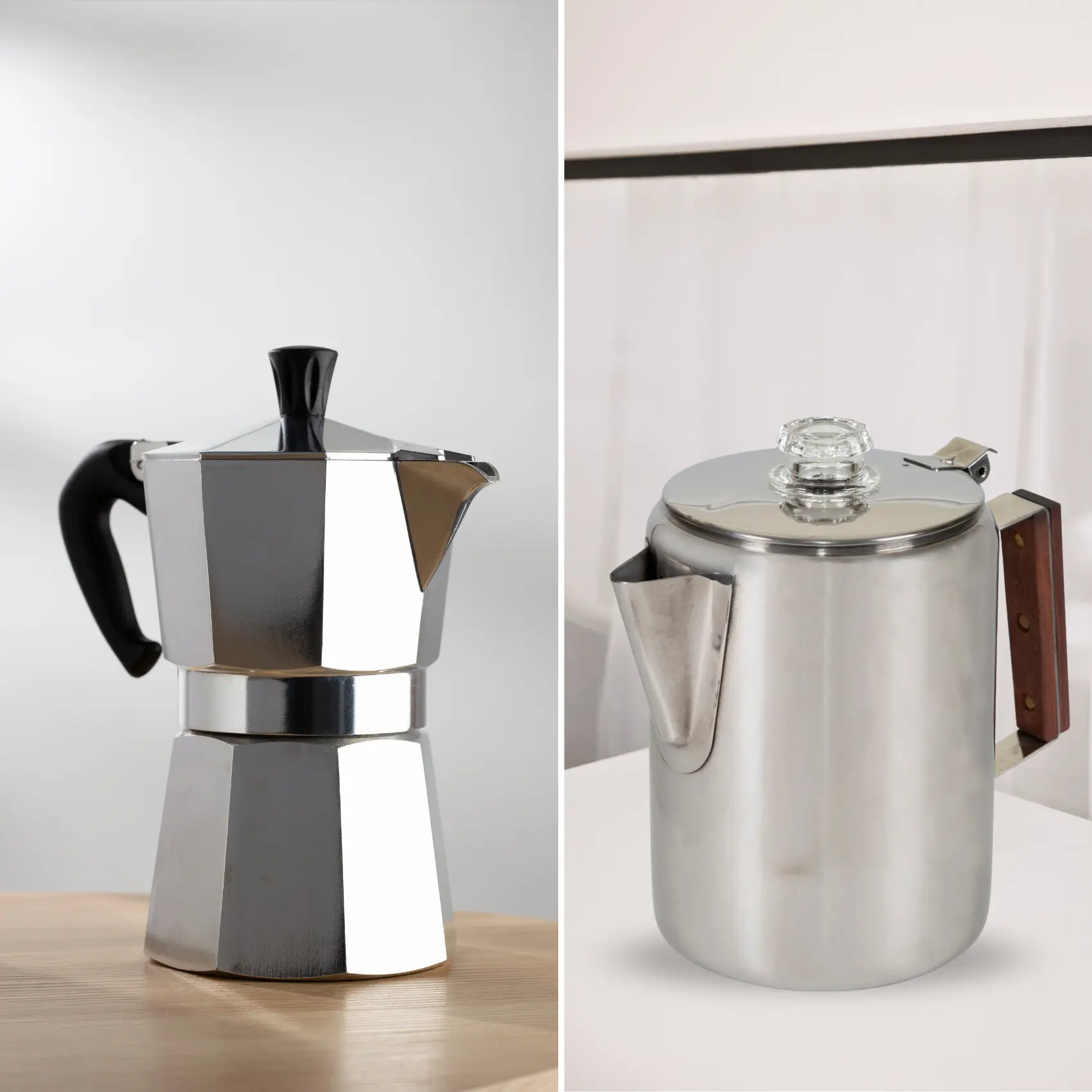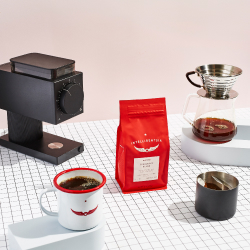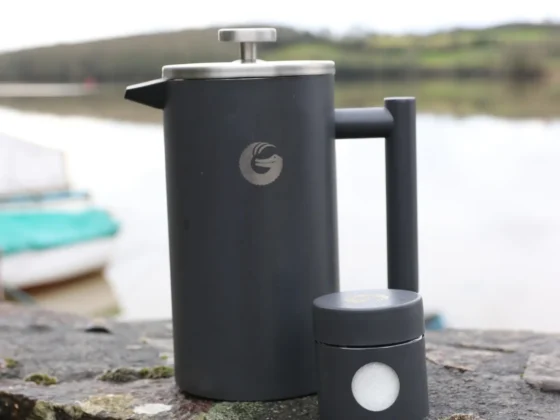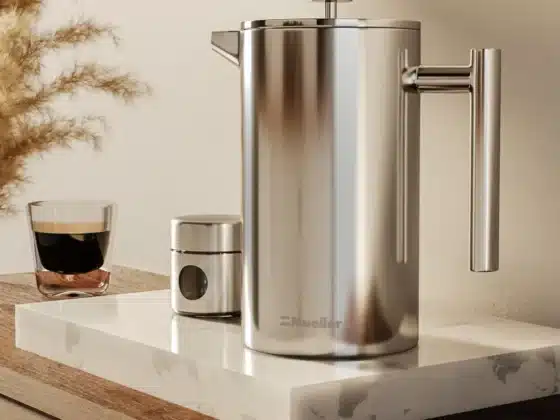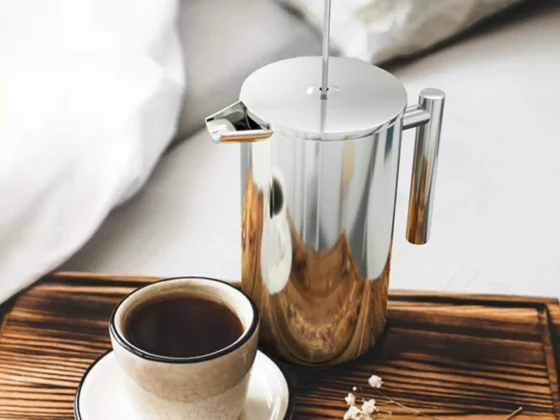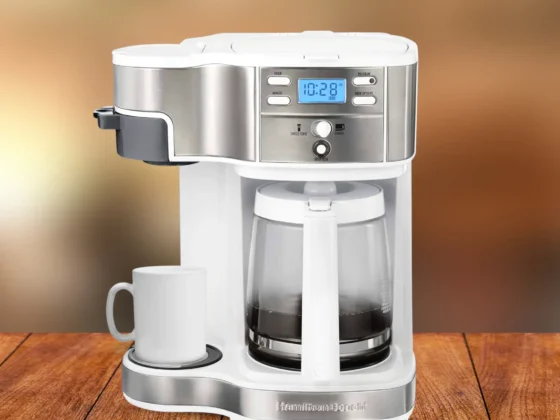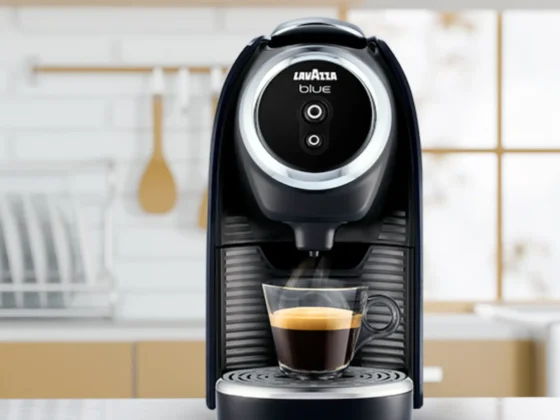In the captivating world of coffee, the age-old debate of moka pot vs percolator continues to brew, with each having its unique rituals, community ties, and distinct flavor profiles. As symbols of tradition and authenticity, these brewing devices have more than just utility; they carry with them stories, memories, and cultural significance. This article delves deep into the essence of these traditional brewing methods, from the rich espresso-like aroma of the Moka pot to the hearty warmth of the percolator, often synonymous with campfire gatherings. Join us as we uncover the nuanced rituals, histories, and lifestyles intertwined with these brewing titans, offering a taste of coffee culture from European terraces to rustic outdoor adventures.
Percolator vs Moka Pot: Key Takeaway
- Historical Significance: The Moka pot embodies European refinement, while the percolator showcases rustic allure, often linked to the outdoors.
- Brewing Techniques: While the Moka pot utilizes pressure to force water through the coffee, extracting a bold and intense flavor, the percolator acts more like a drip brewer, yielding a milder, full-bodied brew.
- Community Ties: The Moka pot symbolizes urban chic, whereas the camping percolator connects with nature lovers and evokes communal campfire moments.
- Flavor Profiles: Coffee from a Moka pot is strong, rich, and espresso-like, while percolator coffee is lighter, yet robust.
- Ease of Use and Maintenance: The Moka pot requires a meticulous approach for perfect brewing, while the percolator is more forgiving and straightforward.
Moka Pot vs Percolator: Historical Journey
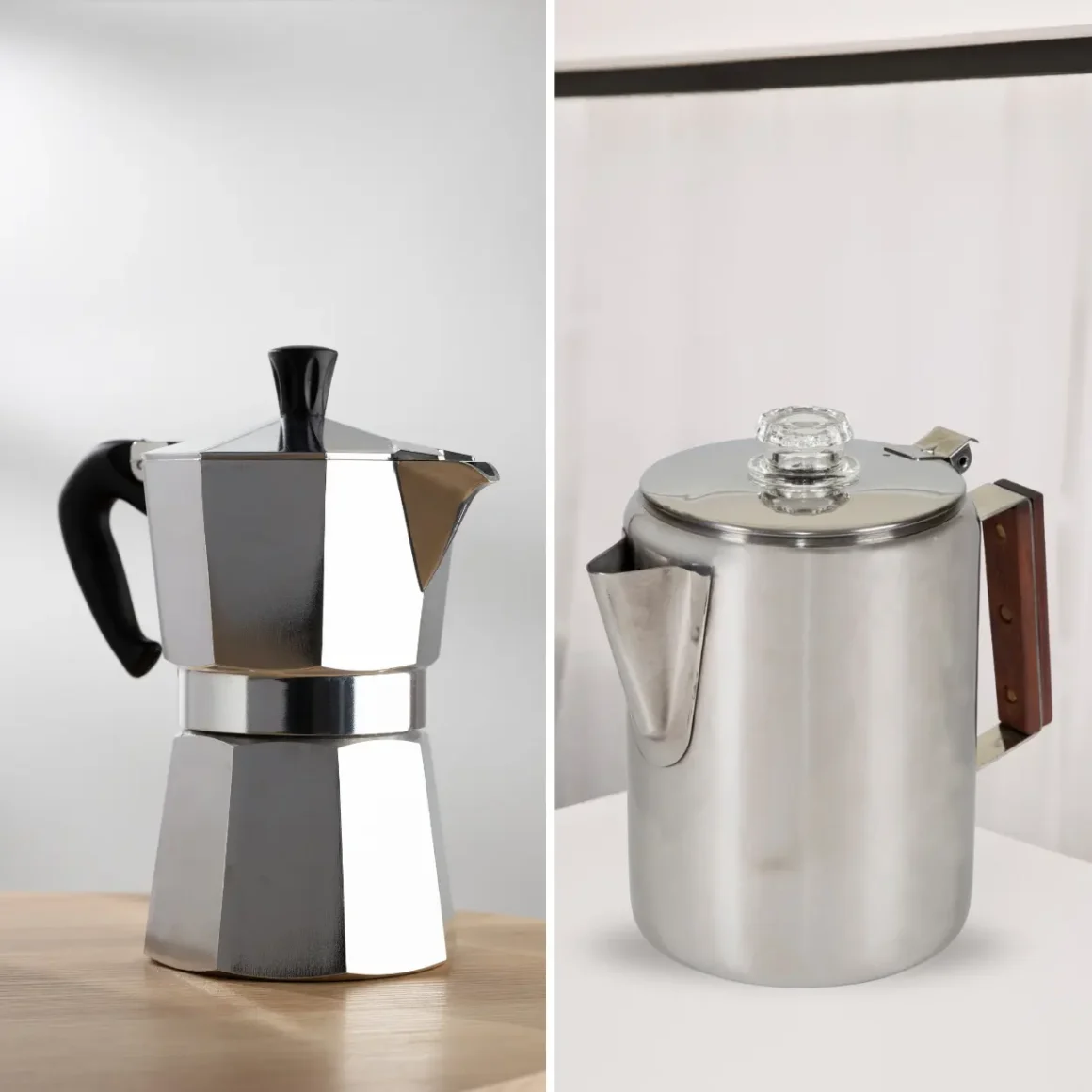
The evolution of coffee brewing methods has witnessed iconic devices that have shaped our coffee-drinking culture worldwide. Diving deep into the histories of two popular methods – the Moka Pot and the Percolator – we discover not just brewing techniques, but also tales of cultures, traditions, and innovations. As we explore the moka pot vs percolator comparison, we’ll unravel the rich tales of these age-old methods.
Birth of Moka Pot in Italian Culture
The Moka Pot, often simply referred to as “la Moka,” is more than just a coffee maker; it’s a cultural emblem. Synonymous with Italian home life and the nation’s love affair with coffee, this coffee machine represents Italy’s ability to marry practical design with artistry. Its story is deeply interwoven with Italian history and daily rituals.
- Origin: Often associated with the Yemeni town of Mocha, this coffee pot’s invention is attributed to the genius of an Italian innovator, Luigi Di Ponti, in 1933. (1)
- Alfonso Bialetti’s Contribution: The design gained commercial prominence when Alfonso Bialetti, a renowned aluminum trader, acquired it. It wasn’t long before this unique coffee maker became synonymous with Italian culture.
- Moka Express: Keeping the tradition alive, Bialetti Industries continues to cherish the original creation, selling it under the name “Moka Express.”
- Material & Design: Primarily crafted from aluminum, with ergonomic Bakelite grips, there are also variants featuring heat-resistant glass or made from other metals.
- Popularity Spread: The post-World War II era saw this coffee maker’s influence extending beyond Italy, making it a household name in southern Europe.
Understanding what a moka pot is means more than just understanding a brewing method; it’s an insight into a rich Italian tradition.
Percolator’s American Legacy
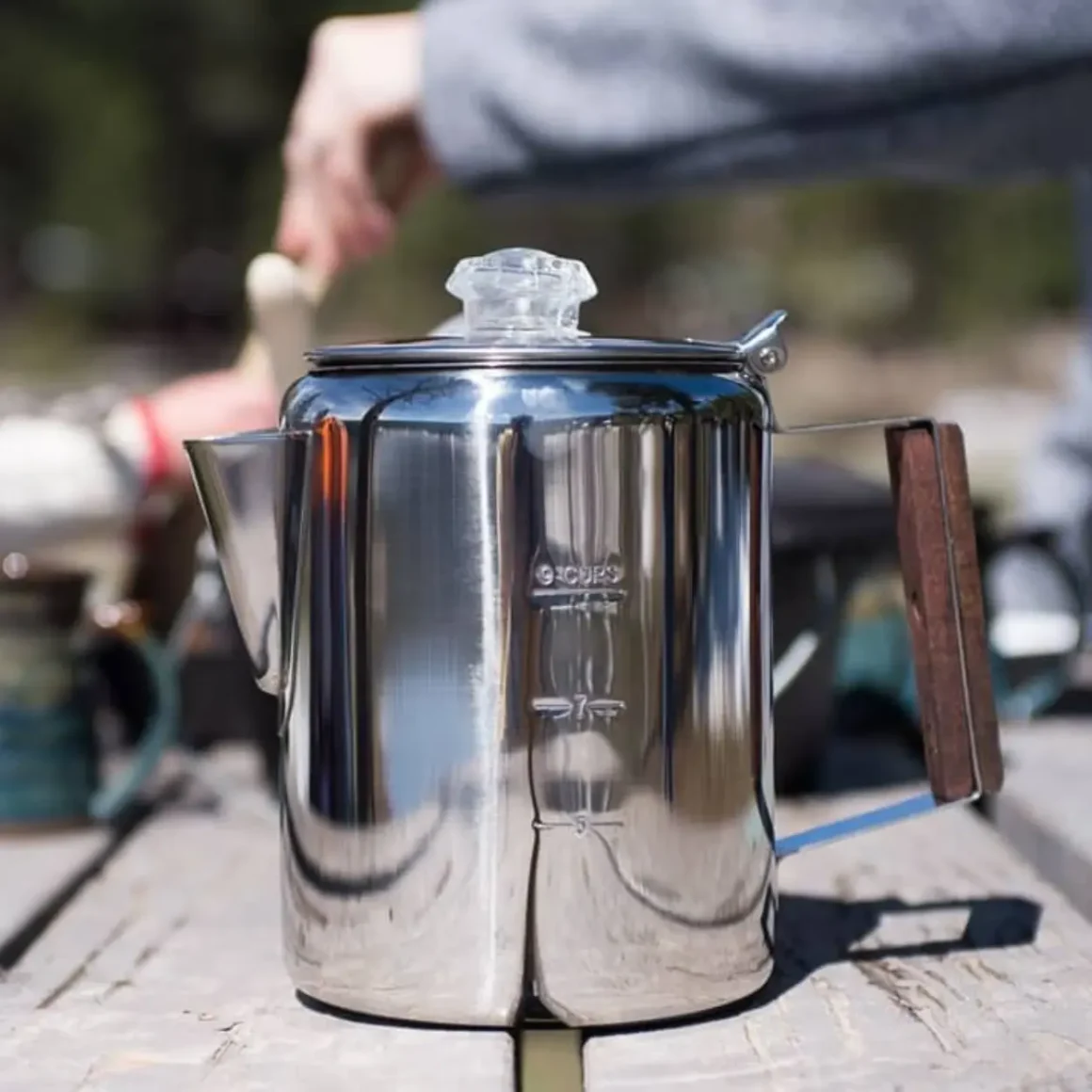
The percolator, a staple in many American households throughout the 20th century, holds a special place in the tapestry of the nation’s coffee culture. While its origins trace back to Europe, the percolator became a symbol of American ingenuity and domestic comfort.
- Inception: The percolator’s innovative design was conceived in 1819 by a Parisian metalworker, Joseph-Henry-Marie Laurens, setting the stage for coffee brewing’s future.
- American Adaptation: James Nason from Franklin, Massachusetts, brought the percolator to American soil, securing its first US patent in 1865. (2)
- Hanson Goodrich’s Influence: By August 1889, an Illinois farmer, Hanson Goodrich, refined the design, introducing features that became characteristic of the modern stove-top percolator.
- Electric Revolution: Fast forward to the early 20th century, electric percolators made their debut, with companies like General Electric at the forefront.
In essence, when one asks, “what is a percolator,” they’re diving into a brewing method deeply embedded in American coffee history.
Evolution of Brew Techniques
As centuries passed, the world witnessed a dynamic shift in brewing techniques.
- Percolation Process: The percolator, with its continuous cycling of near-boiling water through coffee grounds, once dominated households. Yet, its vulnerability to over-brewing saw it overshadowed by drip-brew machines in the 1970s.
- Moka Pot’s Unique Brew: On the other hand, this exquisite coffee maker uses steam pressure to push heated water through crushed beans, offering a distinctly robust coffee.
- Brew Control: Regardless of the method, true coffee aficionados understand the importance of precise brewing control to extract the best flavors.
Overall, while the debate of “moka pot vs percolator” might continue, both have carved unique niches in the annals of coffee history.
Brewing Mechanism
The art of brewing coffee is an intricate blend of science and tradition, with different mechanisms offering unique flavors and experiences. Two such mechanisms, the Moka Pot and the Percolator, have carved their niches in the coffee world. Delving into their workings gives us insight into the detailed processes behind each cup.
Working Principle of a Moka Pot

La Moka, often a staple in Italian households, has a unique brewing mechanism that is both simple and effective.
- Operation Mode: These types of coffee makers can be placed on a traditional flame or an electric stove. Notably, when pondering how to use a moka pot on induction stovetops, only stainless steel models fit the bill.
- Vapor Pressure: The brewing principle hinges on the vapor pressure, which is amplified by heating water. This pressure propels the water through the grounds, culminating in brewed coffee in the upper compartment.
- Essential Components: Two critical components ensure efficient functioning – a silicone seal for a secure fit and a safety valve to counteract excessive pressure.
To sum up, this coffee pot leverages pressure and heat in tandem to brew a delightful cup of coffee.
The Percolation Process

The Percolator, a classic in the American coffee landscape, offers a distinct approach to brewing.
- Continuous Brewing: The percolator coffee pot relies on the continuous circulation of near-boiling water through coffee grounds, utilizing gravity to attain the coffee’s desired strength.
- Construction Insight: At the heart of this device is a chamber at its base, closest to the heat source. An interconnected vertical tube stretches from this chamber to the top, housing a perforated basket for the coffee grounds.
- Heating Dynamics: As the base chamber’s water heats, it produces bubbles that push steam upwards through the vertical tube. This steam then disperses water over the coffee grounds, with the freshly brewed coffee dripping back down, initiating the cycle anew.
In a nutshell, the Percolator, with its cyclic brewing, provides a robust and aromatic coffee experience.
Impact on Coffee Extraction
Brewing methods have a significant influence on the extraction process, which in turn affects flavor and aroma.
- Moka Pot’s Overextraction: During this coffee machine’s final brewing stages, as the lower chamber nearly empties, a blend of superheated steam and water moves through the coffee. This phase termed the “strombolian” stage, can swiftly lead to over-extraction, introducing flavors that may not always be desirable.
- Percolator’s Heat Challenge: Coffee percolators expose grounds to heightened temperatures, possibly leading to over-brewed coffee. This over-brewing renders the coffee particularly susceptible to over-extraction.
- Brewing Mastery: Despite their challenges, both devices can yield exceptional coffee when used correctly. Mastery over the brewing process, as many aficionados would attest, can mitigate potential pitfalls, delivering a cup that’s just right.
In essence, understanding the nuances of each brewing method ensures a coffee experience that’s both flavorful and aromatic.
Moka Pot vs Percolator: Flavor Profile
Navigating the world of coffee brewing, enthusiasts often encounter the age-old debate between these two coffee machines. While these apparatuses might have similar design aesthetics, their brewing methods and the resulting flavors are worlds apart. Let’s dive into the intricacies of their flavor profiles and understand the uniqueness each brings to the coffee table.
Moka Pot’s Rich Espresso-like Brew
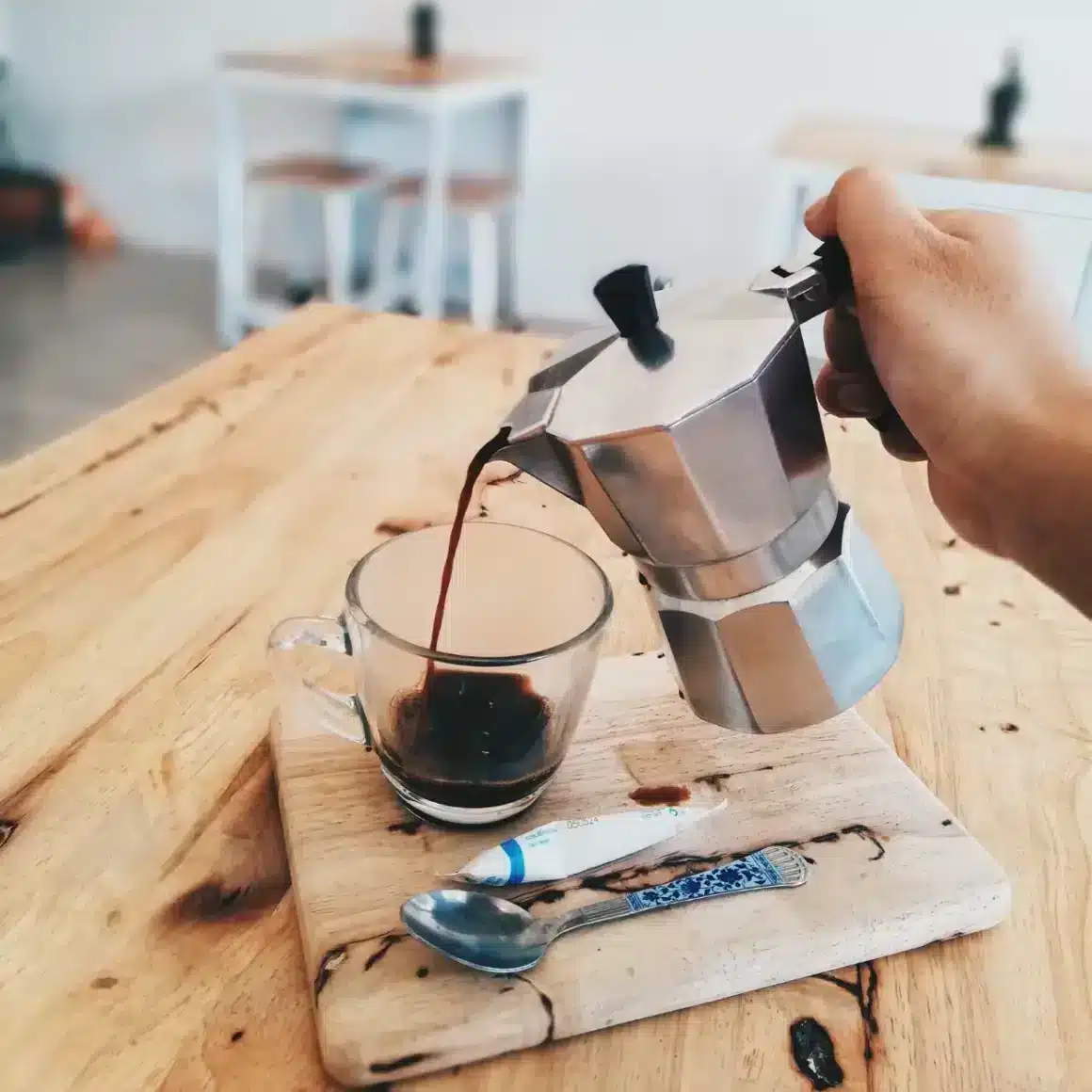
The Moka pot, often hailed as the stovetop espresso creator, offers a brew that’s both dense and layered.
- Brewing Mechanism: The stovetop espresso creator is produced by forcing water, under pressure, through a compacted bed of coffee. This method mimics, to some extent, the way an espresso machine works, hence the nickname.
- Flavor Depth: Renowned for yielding a coffee that’s rich, robust, and slightly on the bitter side, it captures the very soul of deep-roasted beans.
- Serving Suggestions: The coffee can be savored as a potent shot, or one could enhance it with additives such as milk, cream, or sugar. For those with a penchant for milky coffee delights, using a milk frother can whip up a delightful latte or cappuccino.
For those seeking an espresso alternative without investing in specialized equipment, this coffee machine emerges as the hero.
Percolator’s Bold Flavor Characteristic
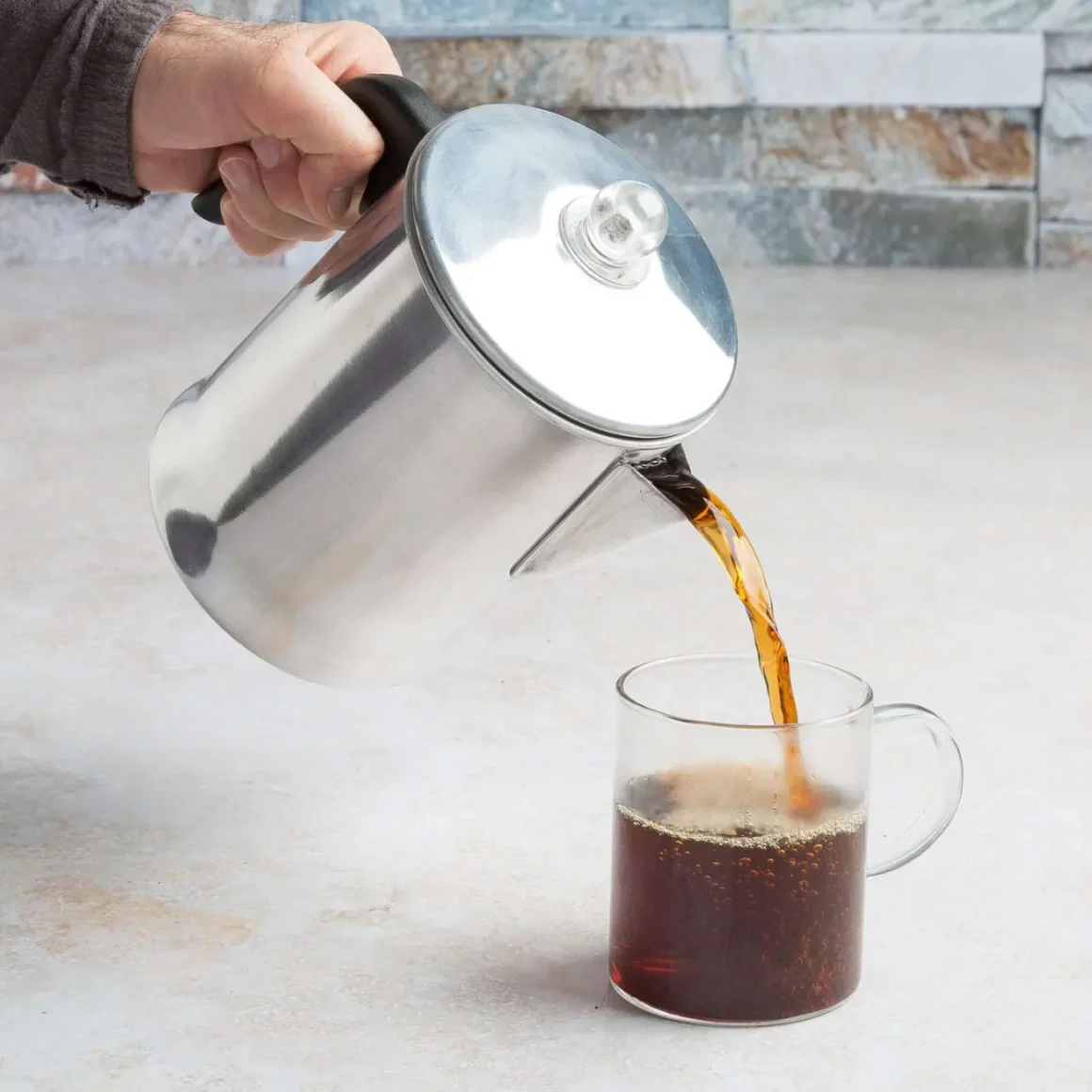
Steering away from the dense profile of moka pot espresso, the percolator coffee pot brings forth a brew that aligns more with drip coffee, yet stands distinct in its flavor.
- Brewing Technique: As previously discussed, the percolator operates on a continual cycle of sending hot water over coffee grounds, intensifying the brew over time. This repeated passage extracts flavors, culminating in a robust cup.
- Flavor Nuances: Percolator coffee resonates with a full-bodied taste, rich aroma, and a flavor profile that can be intensified depending on the duration of brewing.
- Serving Styles: Post brewing, it’s common practice to tailor the coffee to individual preferences by adding cream, sugar, or other desired enhancers.
To sum it up, the percolator crafts a hearty brew that encapsulates the essence of ground coffee beans, offering a robust experience for the palate.
Variables Affecting Taste
The flavor of your coffee isn’t just determined by the brewing mechanism; various variables play a pivotal role.
- Grind Size: For the stove-top espresso maker, a fine grind akin to table salt is recommended, whereas coffee for percolator typically leans towards a coarser texture.
- Brew Time: While moka pots extract flavors rapidly due to pressure, percolators require a longer brew time, which can sometimes lead to over-extraction.
- Bean Quality: The quality and freshness of the beans used are paramount. Both apparatuses will benefit from freshly roasted, high-quality beans.
- Water Quality: The mineral content and purity of water can significantly influence the final taste of your coffee, irrespective of the brewing method.
While the apparatus plays a significant role, the nuances of coffee flavors lie in the finer details of the brewing process.
Moka Pot vs Percolator: Ease of Use and Maintenance
In the vast universe of coffee brewing, not only does the flavor profile matter, but also the ease of operation and long-term maintenance of the brewing apparatus. When choosing between these two coffee makers, many enthusiasts not only ponder the taste they yield but also consider which one complements their lifestyle, skill level, and patience. Let’s navigate through their intricacies and nuances in terms of usability and upkeep.
Learning Curve in Mastering Moka Pot
For those venturing into the realm of this coffee maker, it’s essential to understand that it can be a bit tricky initially, but the rewards, in terms of flavor, are well worth the effort.
- Initial Hiccups: First-time users might face challenges in gauging the correct grind size, water temperature, and the pressure at which the pot operates.
- Tuning the Grind: Achieving the best coffee for moka pot requires a grind that is somewhere between fine espresso and regular drip. It ensures optimal extraction and avoids clogging.
- Heat Management: It’s crucial to master the art of heat control to ensure your brew doesn’t turn out too weak or overly bitter.
- Consistent Experimentation: Achieving the perfect cup might require multiple trials. But once mastered, many swear by the superiority of the best moka pot brew over other methods.
While the learning curve might be steep, the resulting brew is often considered a rich reward for the time and effort invested.
Simplicity and Forgiveness of Percolator
Transitioning to the percolator, one is introduced to a more forgiving and straightforward brewing method.
- Straightforward Operation: With fewer variables to control, many find the percolator more user-friendly, especially for beginners.
- Tolerant to Errors: Even if you get the grind slightly off or let it brew a bit longer, the percolator is usually forgiving, yielding a decent cup most times.
- Versatility: Whether you prefer a mild flavor or a robust brew, adjusting the brewing time allows for a range of flavor profiles.
- Indicators: The characteristic bubbling or “perking” sound serves as a useful indicator for the brewing process, simplifying the user experience.
The percolator, in many ways, offers a more laid-back approach to brewing, making it a favorite for many who prefer simplicity.
Cleaning and Durability

Maintenance and durability play a crucial role in ensuring your coffee apparatus stands the test of time and continues to deliver exceptional brews.
- Moka Pot Maintenance: It’s essential to rinse this coffee pot after every use to prevent coffee oil build-up. Over time, you might also need to replace the gasket and the safety valve to ensure optimal functionality.
- Percolator Maintenance: A percolator requires regular cleaning, especially the tube and the perforated basket, to prevent old coffee residue from affecting the brew’s taste.
- Material Considerations: Both devices come in different materials, but stainless steel variants tend to be more durable and resistant to corrosion.
- General Tips: Avoid using abrasive cleaning pads, which can scratch and damage the surface. Regular descaling, especially in areas with hard water, can also prolong the life of both devices.
While both coffee machines promise a delightful coffee experience, their maintenance and ease of use differ. Depending on personal preferences and commitment to the craft, one can choose the apparatus that best aligns with their coffee journey.
Moka Pot vs Percolator: Points to Ponder

Cost
Moka pots and percolators both offer affordability when set against similar coffee gadgets with equivalent features. Nevertheless, stove top espresso makers generally come with a smaller price tag. For instance, a three-cup Moka pot is almost half the cost of a regular percolator. The key distinction is that a percolator can usually produce over double the amount of coffee. The Moka pot is your best bet if you aim for the most budget-friendly option.
Ease of Use
In terms of simplicity, stove top espresso makers and percolators are on par, and they’re notably less complicated than other coffee-making techniques. Using a percolator is marginally more straightforward since it doesn’t mandate particular fine coffee grounds. Cleaning both devices is a breeze, and neither has moving components. Filling a Moka pot can be a tad tedious due to its compact coffee chamber, but it’s largely negligible.
Taste
Now to the heart of the matter. When it comes to flavor, Moka pots decidedly outshine percolators. Coffee from a Moka pot is rich and intense, yet lacks bitterness, whereas percolators yield inconsistent results. Occasionally, you might get a decent, albeit unexceptional, brew, but at other times, it can turn overly bitter. The unpredictability of a percolator means that your efforts may only minimally influence the final taste.
Community and Lifestyle
The brewing apparatus we choose, much like the attire we do, speaks volumes about our lifestyles and the communities we identify with. With the growing coffee culture, tools like these coffee makers aren’t just methods of brewing; they represent distinct lifestyles, histories, and communities. These devices have woven themselves into our social fabric, reflecting both tradition and evolving tastes.
Moka Pot in Modern Coffee Culture
The Moka pot, often associated with European terraces and passionate Italian coffee rituals, has found its place in modern coffee culture worldwide.
- Symbol of Tradition: For many, this coffee pot is a cherished heirloom, passed down through generations, symbolizing family memories and morning rituals.
- Modern Revival: With the surge of interest in artisanal coffee preparation, this coffee maker has been rediscovered by younger generations eager to recreate authentic coffee experiences.
- Urban Aesthetic: Its classic design has become an urban kitchen staple, symbolizing sophistication and a taste for rich, bold flavors.
- Sustainability Edge: In an era of environmental consciousness, the stove top espresso maker, with its durability and absence of paper filters, appeals to the eco-friendly consumer.
As we navigate the era of third-wave coffee, this distinguished coffee machine stands as a testament to timeless traditions melding seamlessly with contemporary tastes.
Percolator’s Resurgence in Campfire Settings
From being a household staple in the past, the percolator, especially the camping percolator, has seen a revival, primarily in outdoor settings.
- Nostalgic Appeal: For many, the percolator evokes memories of simpler times and has become synonymous with the rustic charm of campfires and cozy gatherings.
- Outdoor Essential: Its rugged design and ease of use make the percolator an essential companion for camping trips and outdoor adventures.
- Bonding Tool: The communal nature of the percolator, brewing coffee for many, becomes a focal point for social interactions in group settings.
- Versatility: Beyond coffee, many use the percolator to heat water for other campsite needs, showcasing its multifunctional appeal.
The percolator, with its hearty brew and rugged charm, has become an emblem of the great outdoors, connecting coffee lovers with nature.
Influence on Coffee Appreciation
The ways we brew and savor coffee play pivotal roles in shaping our appreciation for this age-old beverage.
- Taste Exploration: Different brewing methods highlight varied flavor profiles. While the Moka pot emphasizes bold, intense flavors, the percolator offers a milder, full-bodied brew.
- Ritual Significance: The brewing process, be it the meticulous preparation with a stove top espresso maker or the patient wait with a percolator, adds a ritualistic aspect, deepening our connection with each cup.
- Community Creation: Coffee brewing methods often foster communities. Be it forums discussing the perfect Moka pot technique or campers sharing their percolator stories, these methods bring enthusiasts together.
- Evolving Palates: Exposure to different brewing methods broadens our palates, making us more discerning coffee consumers and deepening our appreciation for the craft.
In essence, our brewing choices influence not just the flavors we relish but also shape our journey of coffee appreciation, connecting us with larger communities and enriching traditions.
Moka Pot vs Percolator: Conclusion
In the spirited journey of moka pot vs percolator, we’ve traversed through time-honored traditions, modern adaptations, and the rich tapestries of communities that hold these brewing methods dear. Both devices, deeply rooted in history, offer more than just a cup of coffee; they provide experiences, evoke memories, and symbolize distinct lifestyles. From the urban sophistication of the stove-top espresso maker to the rugged charm of the percolator, our exploration reaffirms that coffee is not just a beverage but a ritual, an art, and a reflection of culture.
Whether you’re seeking the intense flavors reminiscent of European cafes or the comforting brew of campfire gatherings, the choice between these coffee makers ultimately boils down to personal preference and the experience one wishes to savor. As we close this chapter, we’re reminded that, in the world of coffee, every brew tells a story, and every sip is a connection to a rich legacy.
FAQ
What are the environmental impacts of using a Percolator versus a Moka Pot?
Both have minimal environmental impact as they're reusable, but the material and manufacturing process could contribute differently to their carbon footprint.
How do grind size and coffee bean type affect the brewing process in both methods?
Grind size affects extraction time and flavor, with finer grinds suitable for Moka pots and coarser for percolators; bean type dictates the overall taste and aroma.
Is there a notable difference in caffeine content between coffee brewed with a Moka Pot and a Percolator?
Yes, Moka pots generally produce coffee with higher caffeine content due to its concentrated brew, compared to the milder brew of percolators.
Can the brewing time be adjusted to influence the flavor profile in both brewing methods?
Absolutely, adjusting brewing time can either intensify or mellow the coffee's flavor in both methods.
